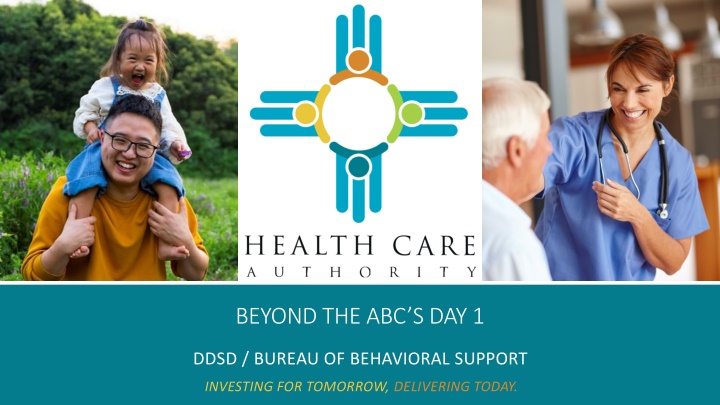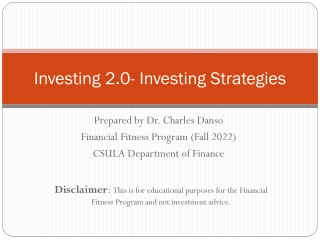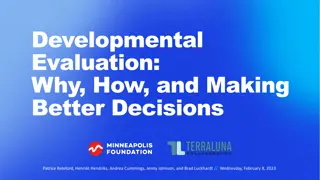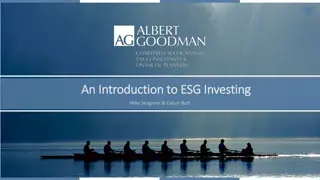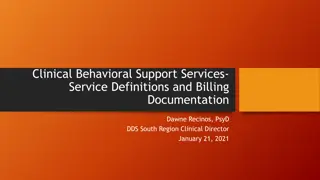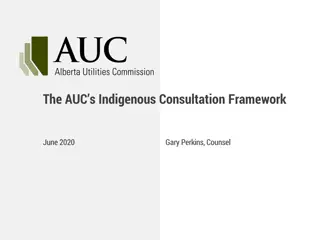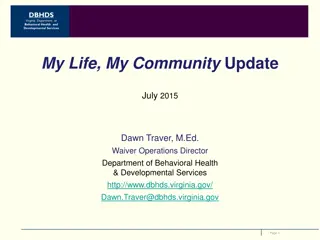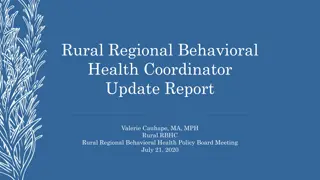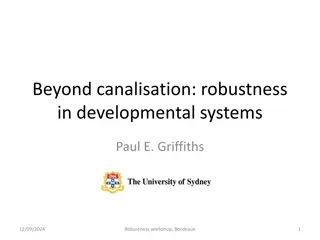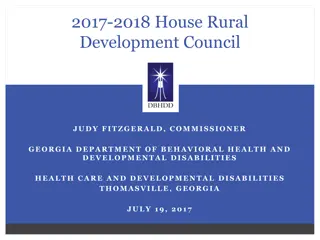Investing for Tomorrow: Behavioral Support Consultation and Developmental Disability Waiver System
Behavioral Support Consultation in New Mexico's Developmental Disability Waiver System aims to increase understanding, provide support, and develop skills for individuals and teams. Learn about the Bureau of Behavioral Support, the role of a BSC, and the importance of Positive Behavior Support. Explore learning objectives and the mission of BBS in delivering quality services today and investing for a better tomorrow.
Uploaded on Feb 21, 2025 | 0 Views
Download Presentation

Please find below an Image/Link to download the presentation.
The content on the website is provided AS IS for your information and personal use only. It may not be sold, licensed, or shared on other websites without obtaining consent from the author.If you encounter any issues during the download, it is possible that the publisher has removed the file from their server.
You are allowed to download the files provided on this website for personal or commercial use, subject to the condition that they are used lawfully. All files are the property of their respective owners.
The content on the website is provided AS IS for your information and personal use only. It may not be sold, licensed, or shared on other websites without obtaining consent from the author.
E N D
Presentation Transcript
BEYOND THE ABCS DAY 1 DDSD / BUREAU OF BEHAVIORAL SUPPORT INVESTING FOR TOMORROW, DELIVERING TODAY.
POWERPOINT DISCLAIMER: POWERPOINT DISCLAIMER: PowerPoint slides are updated more frequently than corresponding videos. The content is consistent, but it is not always perfectly aligned. Investing for tomorrow, delivering today.
BEHAVIOR SUPPORT CONSULTATION IN NEW MEXICOS BEHAVIOR SUPPORT CONSULTATION IN NEW MEXICO S DEVELOPMENTAL DISABILITY WAIVER SYSTEM DEVELOPMENTAL DISABILITY WAIVER SYSTEM INCREASE UNDERSTANDING - The Role - The Person - The Team PROVIDE SUPPORT - The Person - The Team - Each Other DEVELOP SKILLS - The Person s - Your Own - The Team s Jason Buckles, PhD, LPCC Jason.k.buckles@gmail.com 505-615-2223 Heather Clark-Kuhn, DBH, LPCC heather.clark@hca.nm.gov 505-363-0371 Investing for tomorrow, delivering today.
WHY BE A BSC? What brought you to this work? What keeps you in this work? What are the threats to your work? What do you wish we could change in this field? Investing for tomorrow, delivering today.
LEARNING OBJECTIVES LEARNING OBJECTIVES Participants will: Be introduced to the organization of BBS. Be exposed to the concept of Positive Behavior Support and quality of life and how these practices inform the work of a BSC. Investing for tomorrow, delivering today.
WHAT IS BUREAU OF BEHAVIORAL SUPPORT? WHAT IS THE BUREAU OF BEHAVIOR SUPPORT? WHAT IS BEHAVIOR SUPPORT CONSULTATION? Investing for tomorrow, delivering today.
BBS A GENERAL OVERVIEW WHAT WE DO ORGANIZATION CONTACT INFORMATION CRISIS LINE Investing for tomorrow, delivering today.
WHAT IS BBS? BBS is a statewide office of the Developmental Disabilities Supports Division under the New Mexico Department of Health. Oversees several services/programs on the New Mexico Developmental Disabilities Waiver (DD Waiver). The Waiver waives institutional placement in favor of community-based services In General: BBS provides oversight, direction, support, and assistance from the perspective of Positive Behavior Supports. Trainings, examples, systems-level organization; We prefer voluntary but have the option of more direct actions; Direct support in team or on-site settings; Feedback and guidance on written materials. Investing for tomorrow, delivering today.
THE ORGANIZATION OF BBS CHIEF Susan Seefeldt Supv/Oversight of all BBS, Mgt of monies/contracts, Systems Development/Standards STATEWIDE CLINICAL DIRECTOR HEATHER CLARK-Kuhn Supv. Of Reg. Beh. Spec; Development of Positive Beh. Support System STATEWIDE CRISIS COORDINATOR Gabe Vigil POSITIVE BEHAVIOR SUPPORT CONSULTANT Oversight of Reg. Crisis Spec and Crisis Supports Jason Buckles PhD REGIONAL CRISIS SPECIALISTS REGIONAL BEHAVIOR SPECIALISTS Metro, NW, NE, SW, SE Metro, NW, NE, SW, SE Investing for tomorrow, delivering today.
**BBS CRISIS LINE** (505) 250-4292 Situations when this should be utilized We do not normally provide on-site crisis response/behavioral support/intervention. Investing for tomorrow, delivering today.
WHAT IS BEHAVIOR SUPPORT CONSULTATION? The unique system in New Mexico The Consultation Model: What does this mean? How is it different from therapy, counseling etc.? Can I still be a counselor to individuals on the Waiver? BSC is a team (hopefully consensus) method of: Initial and ongoing assessment of behavioral and skill building needs via the lens of the clinical necessity criteria (The PBSA); Providing written guidelines for support, education, and integration of individuals receiving DD Waiver services (The PBSP, BCIP, PPMP, and Risk Management Plan); Providing training to direct support professionals, families, other team members regarding all of the above. Investing for tomorrow, delivering today.
WHAT IS BEHAVIOR SUPPORT CONSULTATION? SEE THE SERVICE STANDARDS Service Requirements 12.2.3 Behavioral Support Consultation (BSC) services are intended to enhance the DD Waiver participant s quality of life by providing PBS as the person works on functional and relational skills. BSC services identify distracting, disruptive, and/or destructive behavior that impacts quality of life and provides specific prevention and intervention strategies to manage and lessen the risks these behaviors present. While other service system settings (e.g., SSE) and generic community settings (e.g., adult continuing education) are also considered and utilized when needed, BSC services do not include individual or group therapy, or any other mental health or behavioral health services that would typically be provided through the Medicaid state plan benefits. Assessment of the person and his/her environment, including barriers to independent functioning; Design and testing of strategies to address concerns and build on strengths and skills for independence; and Writing and training plans in a way that the person and Direct Support Personnel (DSP) can understand and implement. Investing for tomorrow, delivering today.
WHAT IS BEHAVIOR SUPPORT CONSULTATION? Develop behavior support strategies to lessen the negative impact of contributing factors to enhance the person s autonomy and self- determination; Provide IDT members, including DSP, with training, materials and/or other relevant information needed to successfully implement the PBSP and perform any ongoing data collection or provider reporting required by the PBSP and all other related plans (BCIP, PPMP, or RMP); Train staff, and/or an agency designated trainer; Collaborate with medical personnel, ancillary therapies, and Provider Agencies of Living Supports (Family Living, Supported Living, IMLS), CIHS, CIE, and CCS to promote coherent and coordinated support efforts, including mutual scheduling of timely training sessions; Schedule training in appropriate groupings when possible, to maximize time efficiency for all participants; Investing for tomorrow, delivering today.
WHAT IS BEHAVIOR SUPPORT CONSULTATION? In addition to requirements outlined for the IDT, the BSC must: Assist the IDT in determining how to best address the person s socialization and sexuality needs; Delineate supports and training to meet socialization and sexuality needs in the PBSA, and outline any strategies that will meet those needs in the PBSP (if required); Integrate goals, objectives, and strategies into the PBSP and TSS as indicated when the FRC is needed; Provide support and determine whether there is a need for additional behavioral health treatment when there are issues related to sexual victimization; and Request assistance from BBS on any additional issues or concerns related to sexuality needs. Reference: 5.4.2 BSC Roles and Responsibilities p. 46 Investing for tomorrow, delivering today.
WHAT IS BEHAVIOR SUPPORT CONSULTATION? The Many Hats and Duties Presence at Day Program, Home, Work, Community Trainer Trainee Observer, Intervener, Therapist, Liaison, Translator Political Scientist Written, Spoken, and Non-Verbal communicator Role Model Investing for tomorrow, delivering today.
17 REVIEW 1. What is the Bureau of Behavioral Support (BBS)? a. Statewide office of DDSD under DOH b. Provides oversight, direction, support and assistance from a Positive Behavior Support perspective. c. Provides crisis supports to crisis providers. d. All of the above Investing for tomorrow, delivering today.
18 REVIEW 1. What is the Behavior Support Consultation? a. Assist IDT how to best address the persons socialization and sexuality needs. b. Integrate goals, objectives and strategies into the Positive Behavior Support Plan (PBSP) and Teaching and Support Strategies (TSS) as indicated. c. Outline strategies needed for the PBSP. d. All of the above Investing for tomorrow, delivering today.
LEARNING OBJECTIVES Participants will: Understand the components of the documents associated with work as a BSC (i.e. PBSA, PBSP, BCIP, PPMP, RMP) including: Introduction to the concept, components, and process of Functional Assessment and behavioral planning; Methods of Crisis Prevention and Intervention Planning; Structure and intention of the Semi-Annual Report When s and How s of the Risk Management Plan Investing for tomorrow, delivering today.
THE POSITIVE BEHAVIOR SUPPORTS ASSESSMENT (PBSA) I. What is it and why do we do it? II. What do the standards say? III. An exploration of the required parts IV. Frequently asked questions about PBSAs BBS 2018 Investing for tomorrow, delivering today.
THE PBSA WHAT IS IT AND WHY DO WE DO IT? What is it? A wide-ranging dynamic assessment that covers various aspects of an individual s history, current patterns, barriers to growth. The main document for justification of Medicaid expenditure. Why do we do it? Captures a specific period of time in an organized and replicable manner; Helps to guide the interventions, support methods, staff duties, and team needs. Investing for tomorrow, delivering today.
THE PBSA WHAT DO THE STANDARDS SAY? The second semi-annual report is integrated into the annual report or professional assessment/annual re-evaluation when applicable and is due 14 calendar days prior to the annual ISP meeting. Note: The second semi-annual report is embedded into what BSC s commonly refer to as the annual assessment (p236) Documentation required for clinical justification is created during the planning process and should be available to the CM as soon as the DD Waiver services are identified, and no later than 14 days after the ISP meeting. Examples of suggested clinical documentation are: (p72). The PBSA is most robust and common document used in this example. Investing for tomorrow, delivering today.
THE PBSA WHAT DO THE STANDARDS SAY? After the designated training of DSP, the BSC will follow up with observation of DSP and, if indicated, provide individual or group re- training within 30 calendar days. (p134) The BSC Provider Agency must ensure documentation contains all requisite components and meets the following requirements. All documents (except a BSC s progress notes and semi-annual reports) are a billable activity and must be submitted per the person s ISP budget year. BSCs must provide PBSAs to core IDT members at least two weeks prior to the scheduled annual IDT meeting. PBSPs and other plans (BCIP, PPMP) will be provided within 30 calendar days of the start of the annual ISP year unless noted otherwise below: (p137) Investing for tomorrow, delivering today.
THE PBSA, WHAT OTHER RESOURCES DO YOU HAVE? The PBSA Guide What we present here follows/expands on this guide You read it we are not going to read it to you Example PBSAs Some written by BBS personnel, some from redacted PBSAs submitted by BSCs in the field; Our hope for an online BBS clearinghouse Consultation with your Agency Director, other BSCs (don t be an island!), and BBS Investing for tomorrow, delivering today.
THE PBSA, GENERAL THINGS TO KEEP IN MIND Aim for the Goldilocks level of detail: Relevant to the clinical necessity criteria; Speak to the most serious current areas of need; Both skill building (increasing behavior) and assessment of challenges (decreasing behavior). Headings are your (and our) friends: From a systems level perspective clear headers and following the format makes Prior Auth, clinical review, and other tasks much easier to accomplish. Call it as you see it: Always with clear use /acknowledgment of multiple perspectives on the team; With necessary political, systems, cultural sensitivity. Investing for tomorrow, delivering today.
7 QUESTIONS AN ASSESSMENT SHOULD BEGIN TO ANSWER 1. How can we help the person to achieve a sense of health and well-being? 2. How can we help the person to expand and deepen his/her relationships? 3. How can we help the person to have more fun in ordinary, everyday community places? 4. How can we help the person to have more power? 5. How can we help the person to make a contribution to others? 6. How can we help the person learn valued skills? 7. How can we help the person's supporters to get the support they need? O Brien & Lyle Responsive Systems Investing for tomorrow, delivering today.
THE PBSA PART A: REFERRAL INFORMATION 1. Reason for Referral As a side note We DO expect an examination and some focus on negative /challenging behavior Our focus on PBS and Positive Practices does not (and never has) imply that you should avoid talking about problems 2. Differential Diagnostic Considerations 3. Referral Source 4. Individuals/Professionals Contributing Information 5. Record Review Investing for tomorrow, delivering today.
THE PBSA PART B: RELEVANT FACTORS/DOMAINS Remember: Factors assessed to prompt concerns meeting INCLUDE CHALLENGES/LIMITS AS WELL AS STRENGTHS IN EACH AREA 1. Individual Attributes As a side note We DO expect an examination and some focus on negative /challenging behavior Our focus on PBS and Positive Practices does not (and never has) imply that you should avoid talking about problems A. BIOLOGICAL AND/OR PHYSIOLOGICAL FACTORS DSM and Medical Diagnoses with your thoughts Psychotropic Medications Intent and effectiveness Your perspective on status and functioning Investing for tomorrow, delivering today.
THE PBSA PART B: RELEVANT FACTORS/DOMAINS 1. Individual Attributes (continued) PROBLEM SOLVING CAPACITY AND MEANS-Conflict, novelty, and generalization INTELLECTUAL STATUS-More than IQ, cognitive ability etc How does the person organize his/her world? And is it functional/useful? CULTURAL ISSUES Not just the typical examination focus on individual, family, or possible institutional cultures. SPIRITUAL BELIEFS More than just religion consider nature, the arts, aesthetics Investing for tomorrow, delivering today.
THE PBSA PART B: RELEVANT FACTORS/DOMAINS 2. RELATIONSHIPS AND ASSOCIATED SKILLS A. COMMUNICATION The Communication Bill of Rights (handout) Receptive and Expressive consult with SLP or include documents Motivation B. SOCIAL COMPETENCE What are the person s relationships? Who, why? ***Intimacy and Sexuality*** C. SELF REGULATION Comfort seeking and Stress Reduction Both strengths and limits/challenges D. EMOTIONAL STATUS Range, variability of affect, means of expressing Investing for tomorrow, delivering today.
THE PBSA PART B: RELEVANT FACTORS/DOMAINS 3. ENVIRONMENTAL FACTORS: Opportunities as well as preferences SETTINGS- A complete description of the settings the person finds physically and psychologically safe (PBSA Guide, p. 3). SOCIAL DENSITY LIGHTING AND NOISE - OT Reports/opinion MOVEMENT PARTICIPATION/EXERCISING INDEPENDENCE SATISFACTION Investing for tomorrow, delivering today.
THE PBSA PART B: RELEVANT FACTORS/DOMAINS 3. ACTIVITY FACTORS: Options and Expectations Consider and address relevant questions: Is the person supported to make and follow through on choices? Is there a balance between familiar routines and more challenging expectations? Are desired outcomes appropriate and compatible with longer ranging individual preferences and quality of life issues? Do providers understand the person s dominant learning style and can they adapt their interactions? Does the person derive a sense of meaning or purpose from their activities? An aside on meaning and purpose intimacy and competency Investing for tomorrow, delivering today.
35 REVIEW What is the Positive Behavior Support Assessment (PBSA)? a. Wide ranging dynamic assessment that covers individual history, current patterns, and barriers to both. b. Assessment with details of every aspect of the persons life from birth. c. Main document for justification of Medicaid expenditures. d. Both A and C. Investing for tomorrow, delivering today.
36 REVIEW Why do we do the Positive Behavior Support Assessment (PBSA)? a. Captures a specific period of time in an organized and replicable manner. b. Because we are told to do it. c. Helps to guide the interventions, support methods, staff duties and team needs. d. Both A and C. Investing for tomorrow, delivering today.
37 REVIEW Relevant Factors & Domains Includes challenges as well as strengths. Includes individual attributes, relationships and associated skills, environmental factors, and activity factors. Referral Information Contains Record reviews Contains references to Individuals contributing the information Investing for tomorrow, delivering today.
THE PBSA PART C: EFFECTIVENESS INDICATORS WHAT IS AN EFFECTIVENESS INDICATOR and WHY DO WE USE THIS LANGUAGE? IN SHORT: When we see progress in the following areas, we tend to see an increase in positive behavior and a decrease in challenging behavior. These, therefore, are the crux of the interventions outlined in the PBSP. Community Integration/Quality of Life Skill Development Challenging Behavior Interdisciplinary Team Functioning Investing for tomorrow, delivering today.
THE PBSA PART C: EFFECTIVENESS INDICATORS Community Integration/Quality of Life The essential motivators and factors as stemming from the Individual Attributes etc in earlier sections; Consistent with ISP Goals/Objectives; When well formulated, this can serve as a guide for expectations and opportunities. Investing for tomorrow, delivering today.
THE PBSA PART C: EFFECTIVENESS INDICATORS 1.Community Integration/Quality of Life (Continued) Questions to consider Enjoyed independent activities Times that help is needed Are there things you have to do that you prefer not to? Friends? Unpaid social contacts? What do you do/talk about with friends? Who helps you? Resources I Am Somebody Worksheet Self-Reliance Skills Worksheet Investing for tomorrow, delivering today.
THE PBSA PART C: EFFECTIVENESS INDICATORS 2. Skill Development Remember: Almost always people are doing the best they can with the tools they have. One of our jobs is to provide opportunities to acquire and practice using new tools. Communication and Social Skills Essential Always look at these as opportunities for replacement or functionally equivalent behaviors corollary to any challenging behavior. Investing for tomorrow, delivering today.
THE PBSA PART C: EFFECTIVENESS INDICATORS 3. Challenging Behavior This is where it gets a bit heavy on the more classic behaviorism skills such as a functional assessment. To make this truly usable and valid It is critical that this be done in a standardized manner. The focus can/should be on BOTH challenging and positive behaviors. We recommend limiting this to one or two clear behaviors of concern in a hierarchy from Destructive Disruptive Distracting (for challenging behaviors) and key behaviors connected to the other effectiveness indicators (social, integration, skill building) for positive behaviors. Investing for tomorrow, delivering today.
THE PBSA PART C: EFFECTIVENESS INDICATORS 3. Challenging Behavior Destructive v. Disruptive v. Distracting Destructive physical injury or great emotional harm; Disruptive interrupts habilitation, results in significant negative attention (e.g. verbal threats, obscene/offensive, minor damage Distracting annoying, pesky, undesirable (e.g. perseveration, minor offensive language, lying) Investing for tomorrow, delivering today.
THE PBSA PART C: EFFECTIVENESS INDICATORS 3. Challenging Behavior The Functional Assessment Process (Topography) Name of the Behavior and Thorough Description Examples and Non-Examples Current Frequency/duration Current Severity Precursors Antecedents Possible Functions Investing for tomorrow, delivering today.
THE PBSA PART C: EFFECTIVENESS INDICATORS 3. Challenging Behavior The Functional Assessment Process Name of the Behavior and Thorough Description (Operational Definition) Detailed enough to allow a person to imitate the behavior just by reading the description. Actually do this. It helps. This aids in more accurate tracking of progress. BAD EXAMPLE: Aggression Sean hits others with his hands. This led to a person being tracked as having 25 aggressive events per day at his school. Observation showed that most of these events we just him touching people as he they went by. BUT these did fit the definition as written and he was labeled as highly aggressive . Investing for tomorrow, delivering today.
WHEN WRITING ANY BEHAVIORAL DESCRIPTION: Be CAREFUL Take your time everything else you will do in a PBSP involving this is built off of this first step in the process. Be CLEAR As simple terms as possible no jargon . Be CONCRETE May be somewhat boring or dry . Be COMPREHENSIVE Have you covered all your bases? It s hard to provide too much detail. Investing for tomorrow, delivering today.
THE PBSA PART C: EFFECTIVENESS INDICATORS How do I know if I have a good behavioral definition? The most common mistakes are: Assuming everyone knows what (hitting, slapping, paying attention, appropriate) means so I don t have to describe it Simplifying being too broad Too big of a net False Positives Failing to provide examples and non-examples In the Aggression example above providing some non-examples may have lessened the confusion and mis-coding Investing for tomorrow, delivering today.
THE PBSA PART C: EFFECTIVENESS INDICATORS 3. Challenging behavior The Functional Assessment Process Frequency and/or Duration How often is this occurring? use concrete numbers How long does it last? use concrete numbers **IMPORTANT** How do we define when one incident ends and another begins? EXAMPLE: If Sarah s plan states that she will pay $2.00 for every event of property destruction and she has an episode where she punches 5 holes in the wall Does she have to pay $2.00 or $10.00? The solution in this case was to define Property Destruction events as beginning with the first punch and ending when she has not exhibited any destructive behavior for 10 consecutive minutes. Therefore in the above example she would owe $2.00 as it was one event. Yes this is a Cost Response and is potentially aversive we ll talk about interventions in a bit Investing for tomorrow, delivering today.
THE PBSA PART C: EFFECTIVENESS INDICATORS 3. Challenging behavior The Functional Assessment Process Precursors Answers the question How do we know that the person is building up to the behavior? Observable For example - How do I know a person is going to have a cigarette? Antecedents Answers the question What makes this more likely to occur? or How can I make this person exhibit the behavior? For example What are some typical antecedents to smoking? Investing for tomorrow, delivering today.
THE PBSA PART C: EFFECTIVENESS INDICATORS 3. Challenging behavior The Functional Assessment Process Possible Functions AGAIN VERY IMPORTANT this sets the stage for possible skill building interventions that serve the same or similar purpose to the challenging behavior ATTENTION AVOID/ESCAPE TANGIBLE SENSORY Often a combination. Internal/Sensory can be quite difficult Basically what happens right after the behavioral event? Do they get to go home? Do they get restrained? Get an item? etc Investing for tomorrow, delivering today.
